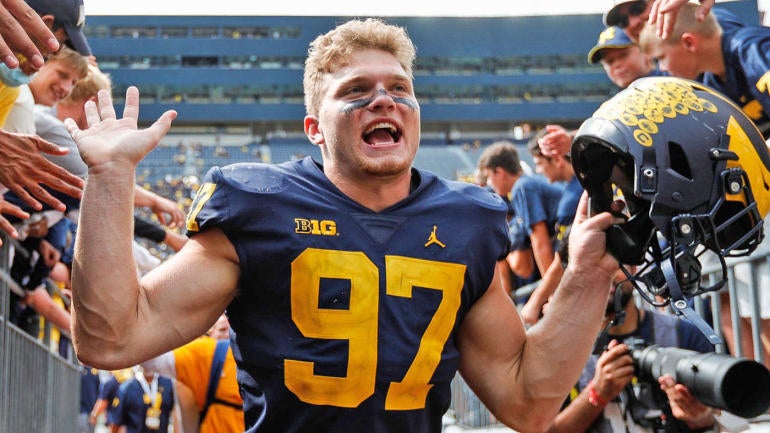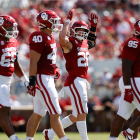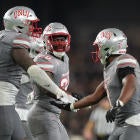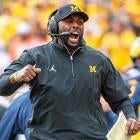
Back just a few months ago over the summer, there weren't many who believed Michigan was capable of reaching this year's College Football Playoff. The Wolverines were coming off a 2-4 season and showed no signs of closing the gap on Ohio State in the Big Ten, forget providing a hint that they could beat the Buckeyes and compete on the national stage.
But I suppose that's why the games are played and not just bantered about.
Michigan set the tone for its season early, disposing of three nonconference opponents with ease. It outscored Western Michigan, eventual MAC champion Northern Illinois and Washington by a combined total of 141-34. While Michigan lost on the road to rival Michigan State the day before Halloween, its nine Big Ten wins -- including the Big Ten Championship Game -- came by an average of 19.8 points with only three one-score wins. That didn't include the long-awaited 42-27 win over Ohio State and the 42-3 dismantling of Iowa that clinched UM's spot in the playoff.
Now that No. 2 Michigan is preparing to face No. 3 Georgia in the Orange Bowl semifinal, it's gone from a team nobody expected to be in this spot to a touchdown underdog against the nation's top team for most of the season. The Wolverines are even seen as the dark horse to win it all ... but will they? Will Michigan not only get past Georgia but take down the winner of the Cotton Bowl semifinal between No. 1 Alabama and No. 4 Cincinnati, too? Yes, it can, and here's how.
1. Elite pass rush makes a difference
College football used to be a simple game. If you could run the ball and stop the run, you would probably win. Well, the formula has changed a little, but it's essentially the same. At the championship level, it's become more about the ability to move the ball through the air for explosive plays while getting after the other team's quarterback.
Michigan can get after the quarterback. Defensive end Aidan Hutchinson finished second in Heisman Trophy voting this year largely because of that ability. He finished third nationally in sacks (14) and first in QB pressures with 69. Hutchinson wasn't the only nuisance on the Michigan defense, though, as bookend David Ojabo was a nightmare himself. Ojabo ranked 10th nationally with 11 sacks and 40 QB pressures.
The presence of Hutchinson and Ojabo allows Michigan to get pressure on quarterbacks without blitzing, which is a massive advantage. In turn, first-year defensive coordinator Mike MacDonald is free to mix up his coverages and disguise his blitzes. All of this leads to opposing quarterbacks having difficulty reading the defense before the snap and therefore having even less time to diagnose things after the snap as Hutchinson, Ojabo or a previously hidden blitzer bears down on them.
2. Strong offensive line limits exposure
Michigan is a perfect example of why an offensive line is different than every other position on the football field. The Wolverines won the 2021 Joe Moore Award given to the best such unit in the country, and deservedly so. But if you look at the All-Big Ten teams for 2021, only tackle Andrew Stueber was named to the first team. Why? Because Michigan's line isn't about individual talent. It's the entity as a whole that's succeeding.
While simply having talent is essential for any position on the field field, for an offensive line, it's cohesion and familiarity that means more than anything. Everybody on the unit has to know his job on an individual play and execute it. If he doesn't, it leads to failure for the unit nearly every time. Michigan's offensive line rarely fails.
In pass protection, Michigan allowed only 10 sacks on the season. Only Army, an option team, allowed fewer. The team's sack rate allowed of 2.7% ranks second nationally. In the run game, Michigan's 5.31 yards per rush ranked 12th and the 2.39 yards before contact afforded Wolverines ball carriers by their offensive linemen ranked 29th.
Now that line will be tasked with facing one of the best defensive fronts in the nation, and should the Wolverines advance past the Bulldogs, they'll face another stellar unit from either the Crimson Tide or Bearcats. If Michigan's offensive front plays like it has all season, it's a unit that will give the Wolverines a chance against anybody in front of them.
Need more college football in your life? Listen below and subscribe to the Cover 3 Podcast where we give a comprehensive breakdown of the Orange Bowl semifinal.
3. Ability to win both ways offensively
Through Michigan's first four games of the season, it looked like it was employing an option offense. Seriously. The Wolverines ran the ball on 73.6% of their offensive snaps through four games. Some of this was by design (they knew they could overwhelm their opponents), and some was circumstance (they had overwhelmed their opponents and did not need to throw while nursing a huge lead). This carried on through the first half of conference play, just not to the same extent. In wins over Wisconsin, Nebraska and Northwestern, the Wolverines ran 57% of the time.
Then came the Michigan State game, which changed everything. The Wolverines found themselves in a shootout with the Spartans, one they eventually lost, 37-33. The silver lining in the defeat was the success Michigan found through the air that day. That led to UM getting more comfortable with its passing attack, which carried through the rest of the regular season.
While the Wolverines ran 67.2% of the time in the win over Ohio State (the Buckeyes couldn't stop the run, so they saw no reason to throw), in their other four wins since that Michigan State loss, Michigan ran the ball only 51.6% of the time and had a passing efficiency rating of 107.5 with 10 touchdowns and three interceptions. That balance has made the Wolverines offense a lot more difficult to defend because opponents can no longer load up the box with the idea of stopping Hassan Haskins and Blake Corum while forcing Cade McNamara and Michigan's receiving corps to beat them.
Well, let me rephrase that. The opposing defense can still try that; it's just not going to be nearly as effective as they would hope.
Making a CFP case for ... No. 1 Alabama | No. 3 Georgia | No. 4 Cincinnati

















